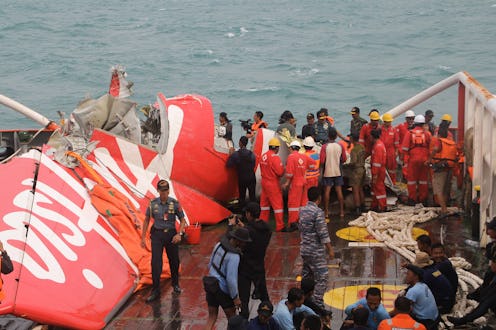News
Indonesia Calls Off AirAsia Flight 8501 Search
Authorities have called off the search Wednesday for the remaining 56 bodies from AirAsia flight QZ 8501 that crashed into the Java Sea on Dec. 28 last year. The plane, which lost contact with air traffic control and disappeared from radar maps after encountering bad weather, went down halfway into the two-hour flight from Surabaya, Indonesia, to Singapore, killing all 155 passengers and seven crew members aboard. Although a complete investigation into the crash won’t be completed and released to the public until August, Indonesian authorities have said that it is likely the aircraft tried to climb too quickly to avoid the bad weather, entered into an aerodynamic stall and then plummeted out of the sky.
Since uncovering wreckage from the plane days after its disappearance, a search and recovery team has battled rough seas to bring up pieces of the plane off the ocean floor and to locate what bodies they can find among the debris. On Jan. 27, the Indonesian military pulled out of the hunt for the remaining passengers, leaving the country’s search and rescue outfit to continue on. The last body was recovered on March 14. After three months of sending volunteer divers down to case the seafloor near where the plane disappeared, AirAsia executive Tony Fernandes explained to the BBC that the search could not continue indefinitely:
We have been successful ... To get more than 50 percent is considered a huge success.
Almost all of the passengers and crew were Indonesian, although one passenger had a British passport. One of the pilots was French.
According to the BBC’s Alice Budisatrijo, the family members still hoping that their loved ones will be recovered were disappointed by the company’s decision but acknowledged that the efforts would have to cease at some point. Malaysia, Singapore, and the United States had contributed boats to the effort. If any other bodies do turn up, the official search team promised to help the families identify them.
Earlier this year, the Indonesian authorities recovered the two black box recorders that should prove the key to uncovering what went wrong. A full investigation into the black box recorders’ data should be released by August. Already, the company has released some information from the cockpit recorder, which registered alarm bells sounding out before the plane crashed. The alarms drown out any conversation between the pilot, Capt. Iriyanto, and his co-pilot, Rémi-Emmanuel Plesel. Prior to the Dec. 28 tragedy, Iriyanto had logged over 20,537 hours of flight time. His partner had 2,275 hours.
Flight QZ 8501 took off from Surabaya, Indonesia’s second largest city, shortly after 5:35 pm local time and climbed to approximately 32,000 feet over the Java Sea. When the plane encountered storm clouds, the pilots asked for permission to take the aircraft higher to avoid the worst of the turbulence. Indonesian officials did not grant the pilots’ request immediately because there were other flights in the area. When air traffic control tried to reach back out to the plane a few minutes later, they received no response. Shortly afterwards, the aircraft disappeared from radar.
The Indonesian Transport Minister, Ignasius Jonan, has said that the pilots appeared to have tried to climb too quickly, a maneuver that risks sending the aircraft into aerodynamic stall. (Reading up on aerodynamic stall is enough to make you think twice about stepping onto a plane – essentially, the plane loses its lift and drops out of the sky like a stone.)
Extreme weather played a primary role in 23 percent of air crashes globally, according to Gloria Kulesa of the Federal Aviation Administration. But pilot and expert Sylvia Wrigley cautions that rarely is a crash caused solely by bad weather:
"I can't think of an accident where weather was the sole cause of the problem," she told BBC. "But there can be a situation where the weather puts the aircraft at a higher risk of going wrong."
Generally, a number of potentially problematic conditions come together into a perfect storm for pilots, to which they then can respond mistakenly. For instance, in the Air France crash that took 228 people down into the mid-Atlantic Ocean in 2009, the plane’s speed gauges malfunctioned due to ice build-up. The pilots, in response, slowed down too much, and the plane stalled.
Images: Getty Images (4)
